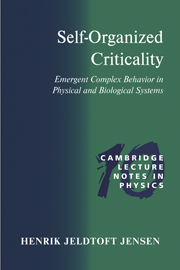Book contents
- Frontmatter
- Contents
- Preface
- Acknowledgment
- 1 Introduction
- 2 Characterization of the SOC State
- 3 Systems Exhibiting SOC
- 4 Computer Models
- 5 The Search for a Formalism
- 6 Is It SOC or Not?
- A Code for the BTW Sandpile
- B Code for the Lattice Gas
- C Code for the Bak-Sneppen Evolution Model
- D Power Spectra and the Correlation Function
- E Statistical Weights in the DDRG
- References
- Index
E - Statistical Weights in the DDRG
Published online by Cambridge University Press: 05 November 2012
- Frontmatter
- Contents
- Preface
- Acknowledgment
- 1 Introduction
- 2 Characterization of the SOC State
- 3 Systems Exhibiting SOC
- 4 Computer Models
- 5 The Search for a Formalism
- 6 Is It SOC or Not?
- A Code for the BTW Sandpile
- B Code for the Lattice Gas
- C Code for the Bak-Sneppen Evolution Model
- D Power Spectra and the Correlation Function
- E Statistical Weights in the DDRG
- References
- Index
Summary
There are four different sets of configurations (see Figure E. 1). The weight factor Wα can be written as a product of the probability that α sites are occupied (and 4 - α are unoccupied) by a degeneracy factor nα: Wα = nαρα (1 - ρ)4-α. The expressions for nα are given in Figure E.1.
The calculations are performed as follows. Let us first consider the α = 2 case. There are K4,2 = 6 configurations for which two of the four sites are critical. Two of these configurations correspond to the critical sites being placed along the diagonal. Such configurations are ignored because they do not meet the spanning criterion. This leaves us with four configurations. For each of these remaining configurations, we have two possible choices when we turn one of the critical sites into an unstable site. In total there are eight different but dynamically equivalent configurations of α = 2. Next, we turn our attention to α = 3 configurations. We can pick three critical sites in K4,3 = 4 different
ways. The α = 3 sites break up into two classes of different dynamical behavior depending on where we choose to position the unstable site among the three critical sites. There are four configurations with the unstable site positioned between the two critical sites (see Figure E.1) and eight configurations where the critical site is located at either end of the string of three sites.
- Type
- Chapter
- Information
- Self-Organized CriticalityEmergent Complex Behavior in Physical and Biological Systems, pp. 146 - 148Publisher: Cambridge University PressPrint publication year: 1998
- 1
- Cited by



